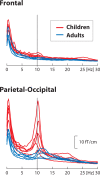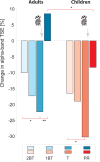Top-down control of MEG alpha-band activity in children performing Categorical N-Back Task
- PMID: 20713071
- PMCID: PMC2976845
- DOI: 10.1016/j.neuropsychologia.2010.08.006
Top-down control of MEG alpha-band activity in children performing Categorical N-Back Task
Abstract
Top-down cognitive control has been associated in adults with the prefrontal-parietal network. In children the brain mechanisms of top-down control have rarely been studied. We examined developmental differences in top-down cognitive control by monitoring event-related desynchronization (ERD) and event-related synchronization (ERS) of alpha-band oscillatory activity (8-13 Hz) during anticipation, target detection and post-response stages of a visual working memory task. Magnetoencephalography (MEG) was used to record brain oscillatory activity from healthy 10-year-old children and young adults performing the Categorical N-Back Task (CNBT). Neuropsychological measures assessing frontal lobe networks were also acquired. Whereas adults showed a modulation of the ERD at the anticipatory stages of CNBT and ERS at the post-response stage, children displayed only some anticipatory modulation of ERD but no ERS at the post-response stage, with alpha-band remaining at a desynchronized state. Since neuropsychological and prior neuroimaging findings indicate that the prefrontal-parietal networks are not fully developed in 10-year olds, and since the children performed as well as the adults on CNBT and yet displayed different patterns of ERD/ERS, we suggest that children may be using different top-down cognitive strategies and, hence, different, developmentally apt neuronal networks.
Copyright © 2010 Elsevier Ltd. All rights reserved.
Figures





Similar articles
-
The roles of alpha oscillation in working memory retention.Brain Behav. 2019 Apr;9(4):e01263. doi: 10.1002/brb3.1263. Epub 2019 Mar 19. Brain Behav. 2019. PMID: 30887701 Free PMC article.
-
Dissociation between MEG alpha modulation and performance accuracy on visual working memory task in obsessive compulsive disorder.Hum Brain Mapp. 2007 Dec;28(12):1401-14. doi: 10.1002/hbm.20365. Hum Brain Mapp. 2007. PMID: 17370341 Free PMC article.
-
Early diagnosis of mild cognitive impairment and Alzheimer's with event-related potentials and event-related desynchronization in N-back working memory tasks.Comput Methods Programs Biomed. 2018 Oct;164:1-13. doi: 10.1016/j.cmpb.2018.06.011. Epub 2018 Jun 27. Comput Methods Programs Biomed. 2018. PMID: 30195417
-
fMRI and MEG in the study of typical and atypical cognitive development.Neurophysiol Clin. 2012 Jan-Feb;42(1-2):19-25. doi: 10.1016/j.neucli.2011.08.002. Epub 2011 Sep 1. Neurophysiol Clin. 2012. PMID: 22200338 Review.
-
Event-related EEG/MEG synchronization and desynchronization: basic principles.Clin Neurophysiol. 1999 Nov;110(11):1842-57. doi: 10.1016/s1388-2457(99)00141-8. Clin Neurophysiol. 1999. PMID: 10576479 Review.
Cited by
-
Posterior brain sensorimotor recruitment for inhibition of delayed responses in children.Exp Brain Res. 2021 Nov;239(11):3221-3242. doi: 10.1007/s00221-021-06191-9. Epub 2021 Aug 27. Exp Brain Res. 2021. PMID: 34448892
-
Prefrontal high gamma during a magnetoencephalographic working memory task.Hum Brain Mapp. 2019 Apr 15;40(6):1774-1785. doi: 10.1002/hbm.24489. Epub 2018 Dec 16. Hum Brain Mapp. 2019. PMID: 30556224 Free PMC article.
-
Frontoparietal network and neuropsychological measures in typically developing children.Neuropsychologia. 2021 Aug 20;159:107914. doi: 10.1016/j.neuropsychologia.2021.107914. Epub 2021 Jun 10. Neuropsychologia. 2021. PMID: 34119500 Free PMC article.
-
Somatosensory evoked field in response to visuotactile stimulation in 3- to 4-year-old children.Front Hum Neurosci. 2014 Mar 24;8:170. doi: 10.3389/fnhum.2014.00170. eCollection 2014. Front Hum Neurosci. 2014. PMID: 24715860 Free PMC article.
-
Maturational Changes in Human Dorsal and Ventral Visual Networks.Cereb Cortex. 2019 Dec 17;29(12):5131-5149. doi: 10.1093/cercor/bhz053. Cereb Cortex. 2019. PMID: 30927361 Free PMC article.
References
-
- Atkinson J, Braddick O, Rose FE, Searcy YM, Wattam-Bell J, Bellugi U. Dorsal-stream motion processing deficits persist into adulthood in Williams syndrome. Neuropsychologia. 2006;44:828–833. - PubMed
-
- Babiloni C, Babiloni F, Carducci F, Cincotti F, Del Percio C, Della Penna S, Franciotti R, Pignotti S, Pizzella V, Rossini PM, Sabatini E, Torquati K, Romani GL. Human alpha rhythms during visual delayed choice reaction time tasks: a magnetoencephalography study. Human Brain Mapping. 2005a;24:184–192. - PMC - PubMed
-
- Babiloni C, Cassetta E, Chiovenda P, Del Percio C, Ercolani. M, Moretti DV, Moffa F, Pasqualetti P, Pizzella ZV, Romani GL, Tecchio F, Zappasodi F, Rossini PM. Alpha rhythms in mild dements during visual delayed choice reaction time tasks: a MEG study. Brain Research Bulletin. 2005b;65:457–470. - PubMed
-
- Babiloni C, Vecchio F, Bultrini A, Luca Romani G, Rossini PM. Pre- and poststimulus alpha rhythms are related to conscious visual perception: a high-resolution EEG study. Cerebral Cortex. 2006;16:1690–1700. - PubMed
-
- Baddeley A. Working Memory. Clarendon Press; Oxford: 1986.

